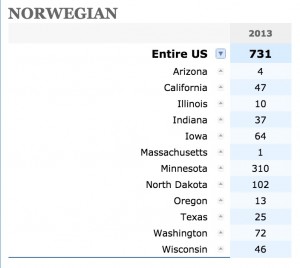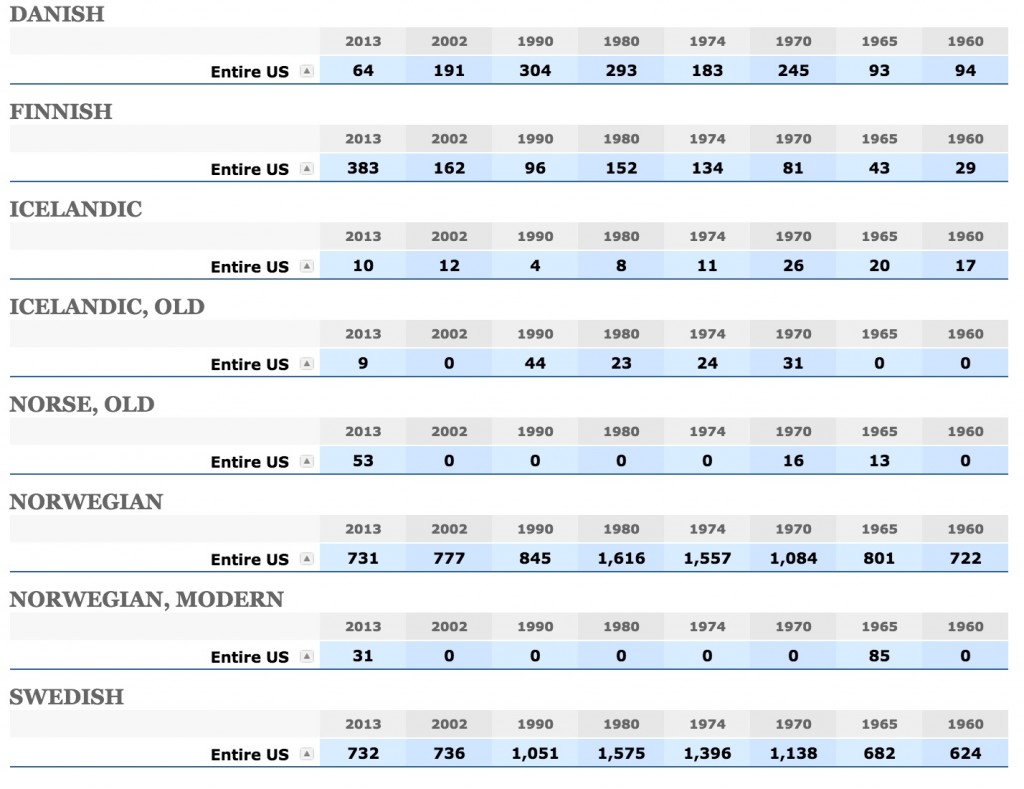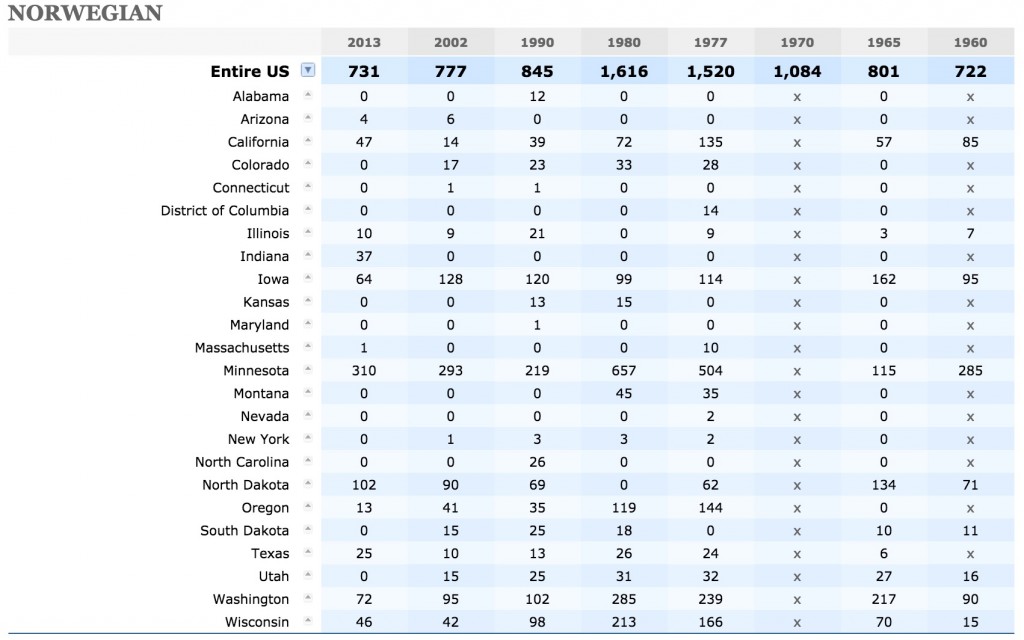The Modern Language Association of America (MLA) released a comprehensive study this month entitled Enrollments in Languages Other Than English in United States Institutions of Higher Education, Fall 2013. Their first paragraph summarizes the project well:
SINCE 1958, the Modern Language Association (MLA) has gathered and analyzed data on undergraduate and graduate course enrollments in languages other than English in United States colleges and universities. The previous survey examined language enrollments in fall 2009; here the MLA presents its twenty-third survey in the series, describing trends in language course enrollments in fall 2013. From 1958 through 2009, the MLA conducted these surveys with the support of the United States Department of Education. The Department of Education’s International Research and Studies Program has not funded new awards since 2010. In 2013, the survey was partially funded by the National Endowment for the Humanities and the National Security Educational Program. (1)
General findings (interesting but not Nordic specific)
Not surprisingly, Spanish is still the most commonly taught language in the US. But, examining the data more thoroughly one sees that it is the first time since data has been collected (1958) that the enrollments dropped (by approx. 70,000!). French still holds the rank of second, but American Sign Language is now in third bumping German to fourth and Italian is in fifth. I find this so interesting because it doesn’t correlate very closely with the current enrollment trends where I teach, at St. Olaf College.
Their research found a total of 248 Less Commonly Taught Languages (LCTLs) were taught in 2013 (which they define as those not in the top 15). Overall, LCTLs saw a 2.6% decrease, but only after they had a huge increase in 2009 and 2006.
What I really appreciate about the MLA report is that they don’t only prepare a lengthy summation of their findings, but they also give the public the data for further investigation. With that I was able to create a number of tables to learn more about Nordic language instruction in the US. Below you will find some of the tables I created using their data which reports enrollments for Nordic Languages in the US from 1960-2013. If you want to look at anything in more depth, check out their Language Enrollment Database.
Nordic Findings
I should start off by saying that I have found several errors in the MLA data, notes are made of these below. I’m sure there are other examples for other languages as well. In terms of helping us see and eventually understand enrollment trends, it does prove to be a very useful tool, we just won’t get too persnickety with details.
I think it’s safe to say that the general consensus amongst those of us who teach Nordic languages in the US is that even though we are small in number, we believe we are a relevant field of study. I think the question is if we are remaining relevant, which in a university setting is frequently defined by enrollment numbers. Some learners begin learning a Nordic language because of their heritage, but a growing number of learners arrive in our classrooms with a plethora of other reasons ready to learn a Nordic language. A big part of our job is to help learners discover the connections Nordic languages have with other fields of study and their free time interests, because that is what keeps their language study relevant.
According to the MLA data, Norwegian has roughly slightly higher enrollment in 2013 as it did in 1960, though it is down roughly 50% since its peak in 1980.

Also interesting to note (if you read my blog post when I originally posted, you’ll notice I updated this), there are two institutions (BYU and Augsburg) reporting “Norwegian, modern” as opposed to “Norwegian” in 2013; this is not nynorsk, this is a reporting glitch. This also happened in 1965 at the University of Minnesota. So this means that total enrollment for Norwegian in 2013 was 762.
The number one question that this does not answer is this: what was going on in the 80s beyond a general resurgence of heritage language learning?
 The findings for where students are enrolled in Norwegian is not overly surprising. Minnesota takes the lead in Norwegian language learning (which should be 325 with Augsburg’s 15 counted under “Norwegian, Modern”), North Dakota teaches the second largest group of Norwegian language learners, followed by Washington in third and then Iowa in the fourth, and there’s a close tie for fifth/ sixth between California and Wisconsin.
The findings for where students are enrolled in Norwegian is not overly surprising. Minnesota takes the lead in Norwegian language learning (which should be 325 with Augsburg’s 15 counted under “Norwegian, Modern”), North Dakota teaches the second largest group of Norwegian language learners, followed by Washington in third and then Iowa in the fourth, and there’s a close tie for fifth/ sixth between California and Wisconsin.
Examining further the enrollments from each state we see that Norwegian instruction has actually increased in some states in the last 20 years (specifically Minnesota, North Dakota, Indiana and Texas); these increases are especially encouraging when factoring in that some of these states have had program closure(s). Knowing the programs in these states, I think these increases are partially thanks to the hard work, clever networking and advertising and ever increasing community outreach of the faculty within these programs.
Data for Nordic, overall
One can also compare the data for enrollment over the years within the Nordic languages as seen below.
 Here, similar to the division of Norwegian, we also see the division of Icelandic (Icelandic/ Old Icelandic/ Old Norse). Here we see that Norwegian has the highest enrollment with Swedish coming in as a close second. Then we have a huge jump to the third highest enrollment, Finnish. Then if tallied as one group Icelandic/ Old Icelandic/ Old Norse and Danish in fourth and fifth. That said, I’m not sure that I know the Icelandic programs well enough to know that those should be tallied together.
Here, similar to the division of Norwegian, we also see the division of Icelandic (Icelandic/ Old Icelandic/ Old Norse). Here we see that Norwegian has the highest enrollment with Swedish coming in as a close second. Then we have a huge jump to the third highest enrollment, Finnish. Then if tallied as one group Icelandic/ Old Icelandic/ Old Norse and Danish in fourth and fifth. That said, I’m not sure that I know the Icelandic programs well enough to know that those should be tallied together.
Data by state (2013)
There isn’t a good table to illustrate the number of states each language is taught in (in 2013). I was surprised with these findings, not that Swedish was in more states than Norwegian, but that Finnish was in so many.
Swedish: 16 states
Norwegian: 13 states (including Norwegian, modern)
Finnish: 10 states
Danish: 6 states
Norse, old: 2 states
Icelandic, old: 1 state
Icelandic: 1 state
Data, by institution (2013)
When examining the number of institutions that teach each language, the languages fall in the same order (again, I had to manually count these, there wasn’t a good table for this).
Swedish: 24 institutions
Norwegian: 20 institutions (including Norwegian, modern)
Finnish: 10 institutions
Danish: 6 institutions
Norse, old: 3 institutions
Icelandic, old: 1 institution
Icelandic: 1 institution
First, what doesn’t come as a shock:
–In general, I’m not too surprised by the 2013 findings. Norwegian and Swedish have followed the same trends though have gone back and forth in terms of the highest enrollment. Norwegian programs are larger but there are more Swedish programs.
–It’s unfortunate (but still not surprising) that Danish has had such a huge decrease in the past 10 years. This is likely due to recent funding cuts which previously supported Danish language instructors. There was a similar proposal (threat?) from the Swedish government this year, but after a large letter writing campaign, the idea was nixed. The Swedish programs should be relieved after seeing how this funding affected enrollment in Danish.
–Sami enrollment isn’t tallied although it is taught. As a survivor of studying this incredibly difficult language, I would guestimate 5 students (on average) studying the language each year for the past 10 years, but my colleagues in Madison would have a better estimate.
What is surprising/ interesting:
—Loistava! The Finns have a 1220% increase since 1960 and a 1360% increase since 2002. I had to look into where these numbers were coming from because I was so taken aback by the data. Well, a good number of them are from Global University which is a part of Iso Kirja, a religious distance education program, part of which is offered in Finnish in the US. I don’t know enough about this other than that it is not a traditional language program and maybe shouldn’t be included in this study, but I could be wrong.
–The reporting glitch with “Norwegian, Modern”. My theory is that a Swede was in charge of the data and wanted to make it look like they have higher enrollment.
What I’m left wondering:
Several universities have begun to offer mixed language intermediate/ advanced language courses. If I understand correctly, it is not taught this way due to instructor or program interest but rather because of lack of funding separate intermediate/ advanced courses. If there is a mixed language course, how are those numbers tallied?
Finally, this study examines enrollment of US colleges/ universities. However, many of us who teach Nordic languages in the US consider our field to include all of North America. Though our colleagues in Canada are few in number, they are a vital part of our field and we are left without their enrollment data. I’m not sure if their data is available anywhere. Canadians? I’d love some feedback on this!
Summary
Overall, I’m satisfied with these figures, I think the data illustrate healthy enrollment. I think it shows that the field of Nordic language learning is still relevant in 2013.
As is explained in the MLA report, this study investigates undergraduate and graduate learning and does not include community education, K-12 and summer programs, all of which are a vital part of overall Nordic language instruction in the US. The individuals teaching in these programs are a connected and integral part of our healthy enrollment numbers. There are very large community education programs through Mindekirken‘s Norwegian Language & Culture Program, and the American Swedish Institute in Minnesota and also the Scandinavian School in California. Additionally, Concordia Language Villages has a thriving language program for children and adults in each of the Nordic languages (except Icelandic).
It will be interesting to see what the future holds. The big question in our field is, how committed to Nordic language instruction is a university or college? Every time one of our colleagues retire, the first question we all have is, will the college/ university continue with the language instruction? Or will a university take that opportunity to “give” the course to a different language?…Or (sigh) to the sciences?
I also wonder if Disney might have helped us with our enrollment in the coming years, if not for Nordic languages in general, then for Norwegian specifically.
Will the Frozen mania continue with little wannabe Elsas enrolling in Norwegian? Knowing my niece, I’m not sure she’ll be able to let this interest go… and that early interest has the potential to positively impact the future of our enrollment.


